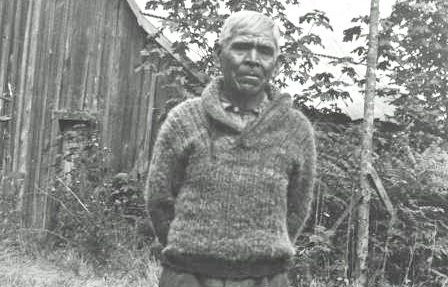By Grant Keddie.
In 1941, World War II was on. At the age of 72, Jimmy Fraser (Kin-Kay-nun; Unthame, Cheachlacth) of the Songhees Nation, stood next to his fellow band members Jack Dick, Roddy Stewart, Art Hall, Clarence Dick, Richard Albany, Dave Fallardeau and Louis Kamai, at the Esquimalt dock yards, famous for their ship building.
The Songhees were being praised for their contribution to the war effort. Like so many other Indigenous people then and before in World War 1, they contributed to the Canadian war effort. The Songhees were being singled out for the work they were doing at the dock yards. The foreman at the dockyards said the Songhees “were the best workers he ever had”. (Colonist 1941). The Navy named one of their ships “War Songhees”.
Figure 1, shows Jimmy Fraser standing near his “big house” on the New Songhees Reserve in July 1934. Newcombe photograph RBCM E974a-XXII/8.
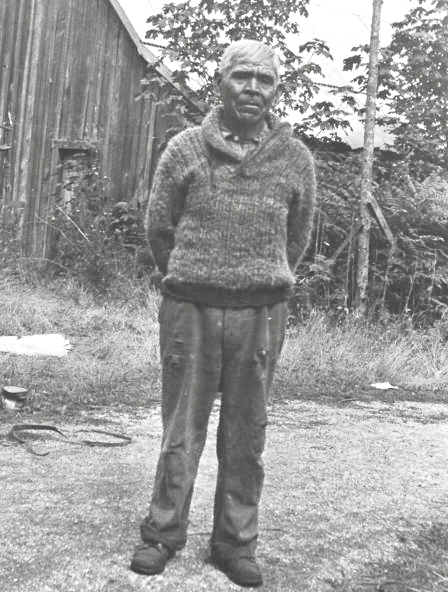
Jimmy was one of the Songhees who straddled the bridge between two worlds. He was born in 1869, only seven years after the devastating smallpox that took the lives of so many Indigenous people. The Songhees were saved by their wise decision to get inoculated by Dr. Helmken and isolating themselves on the Discovery Islands (Keddie 2023). Jimmy lived for 42 years on the Old Songhees Reserve in Victoria harbour and for 52 years on the New Songhees Reserve on Esquimalt Harbour.
Stories in the Press
Jimmy was known as the story teller, and was sought after by the newspapers for stories about local indigenous peoples. He was seen as a “medicine man” and a “weather changer”. He was often interviewed by the local newspapers in the 1950s and early 1960s, to get his opinion on the future weather. The interview articles were sometimes an attempt at humour, with joint titles such as “Indian Prophet Predicts Green Christmas”, to go with the sub-title: “Reindeer Face Tough Job”, to indicate that sledding will be a problem based on Jimmys predictions.
Figure 2, shows a Newspaper reporter in 1904, waiting for Jimmy Fraser (left) with his sister Elizabth Joseph and her husband Daniel to get ready for their photograph. RBCM PN8816.
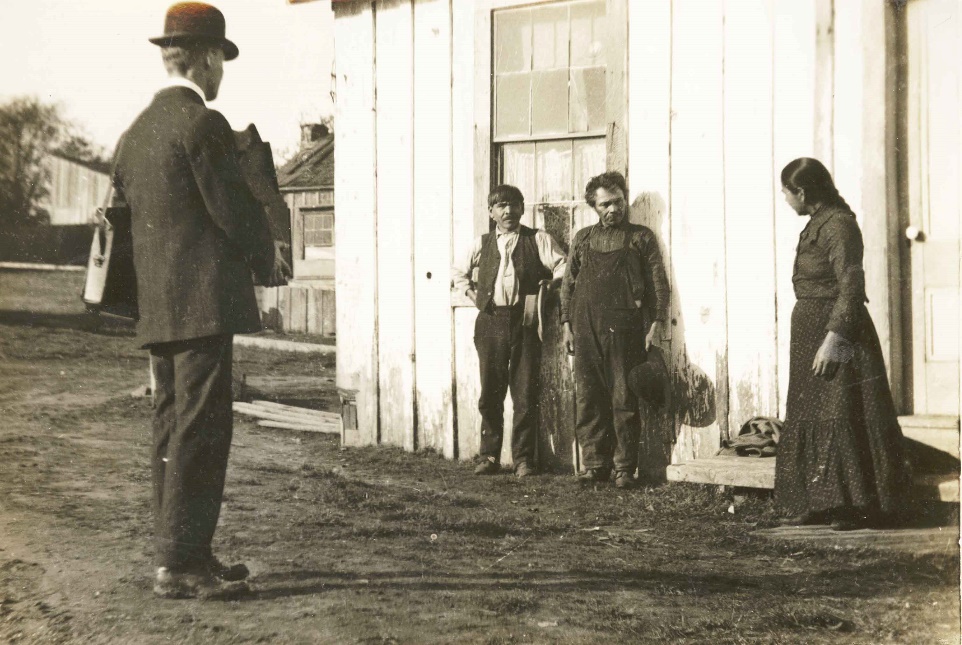
As an example of a more in-depth story, here is one under the title: “Indian Sign Put on Weather. Gods Bury Hatchet”. The Daily Colonist, as was usual at the time, mistakenly presents Indigenous nature spirit beings as equivalent to “gods” of the western world. He writes: “The weather gods must have kissed and made up, because it ain’t gonna rain no more, according to James Fraser, 75- year-old, Indian weatherman. ‘No more rain. Finished now’, Jimmy said last night. The gods who battle for control of the sky cause good or bad weather, he pointed out recently, after predicting a heap of rain. Whichever weather god took the shellacking last Friday wept about one and a half inches of rain all over Victoria. But they buried the hatchet now, Jimmy says, and even it January does happen to be the ‘coldest’ Indian month and therefore a bad old month, the rains have gone. Next month will be the ‘young owl’ Indian moon, he says, and relations between the weather gods may be a little good, even frosty, but Jimmy doubts that there will be any more rain weeping battles for some time. Myth of Frog March is the month called by Indians ‘Frog’ ‘ and you never know which way it will jump as far as weather is concerned”.
Figure 3, Shows Jim Fraser sitting on the steps of his sister’s house with his Nephew Samuel Joseph on the Old Songhees Reserve.
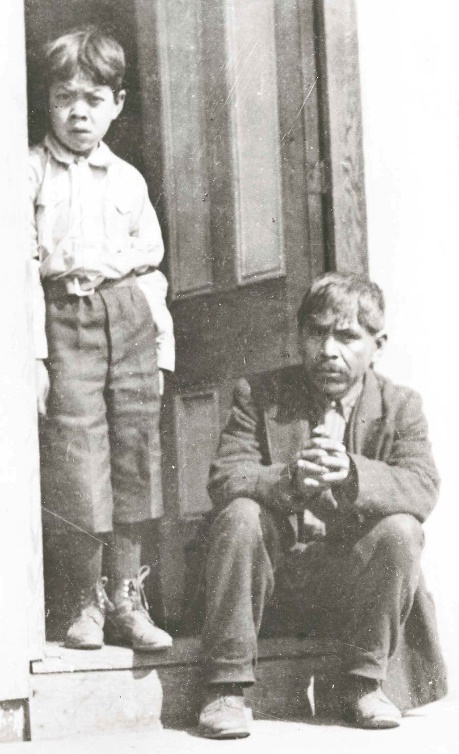
Some articles explain Jimmies tradition way of viewing the world. With the title: “Benevolent Spirits, Smile on Victoria”, they refer to Fraser as a “Well known Indian Weather prophet”. He “says he interceded with ‘Him who dwells above’, known to white men as the sun.” He quotes Fraser’s personal experience in referring to him as a prophet: “Then one day the Great Spirit appeared to me in the form of a sockeye salmon and told me he would protect my people from winter hardships by checking the violence of the north wind.” ( The Daily Colonist 1965-01-10).
In reporting, on December 5, 1967, after Jimmy died in a Chilliwack hospital, the Daily Colonist noted: “He insisted he based his weather predictions on signs of nature, and chats with the spirits of the birds and fish. He regarded the winds, rocks and trees as spirit powers”.
In his interview with anthropologist Wilson Duff, Jimmy said: “I am a wolf”. This means he had a wolf spirit helper, that could help him “draw out deer”. Jimmy preyed to the wolf. He said “I don’t belong salt water, but to mountains some place” (Duff 1952).
Figure 4, shows Cousins of Jimmy Fraser. Left to right: Wilkh James (Colquimalt), Nanaimo. His father was James Selkmalt, his grandfather was Loma “Paramount, chief of the Cowichans”. Edward Charley (Chrew Ktow), Kuper Island. Jimmy Fraser. Harry Henry (Dehilasham), Nanimo. “Grandson of Coal tyhee”.
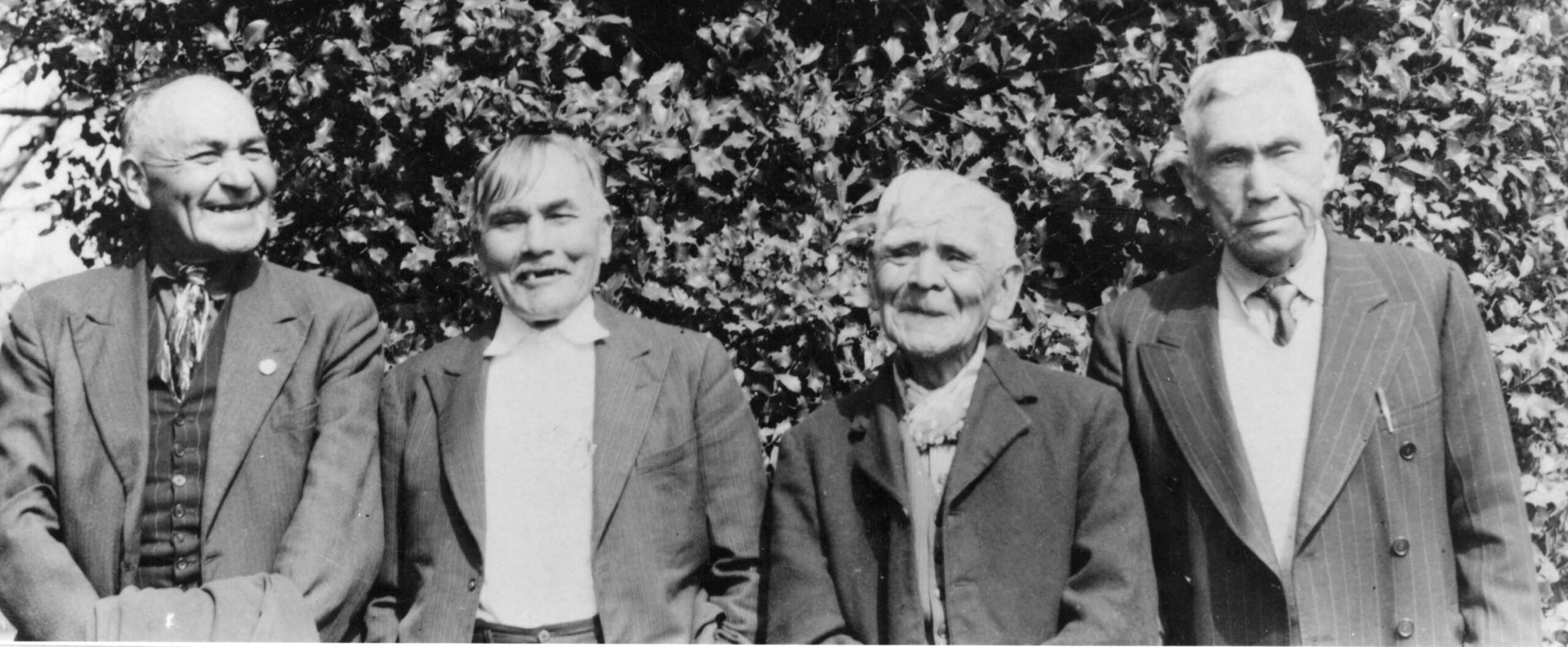
Figure 5, shows Jimmy Frasers big house workshop on the New Reserve with one racing canoe and several fishing canoes. August 1934.
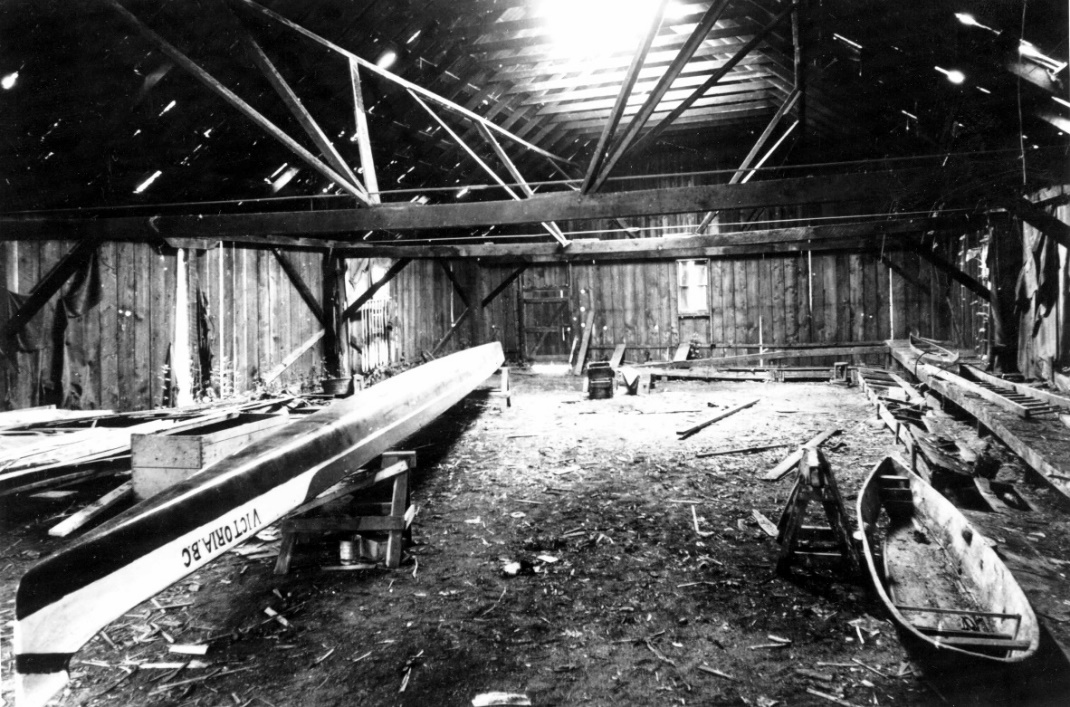
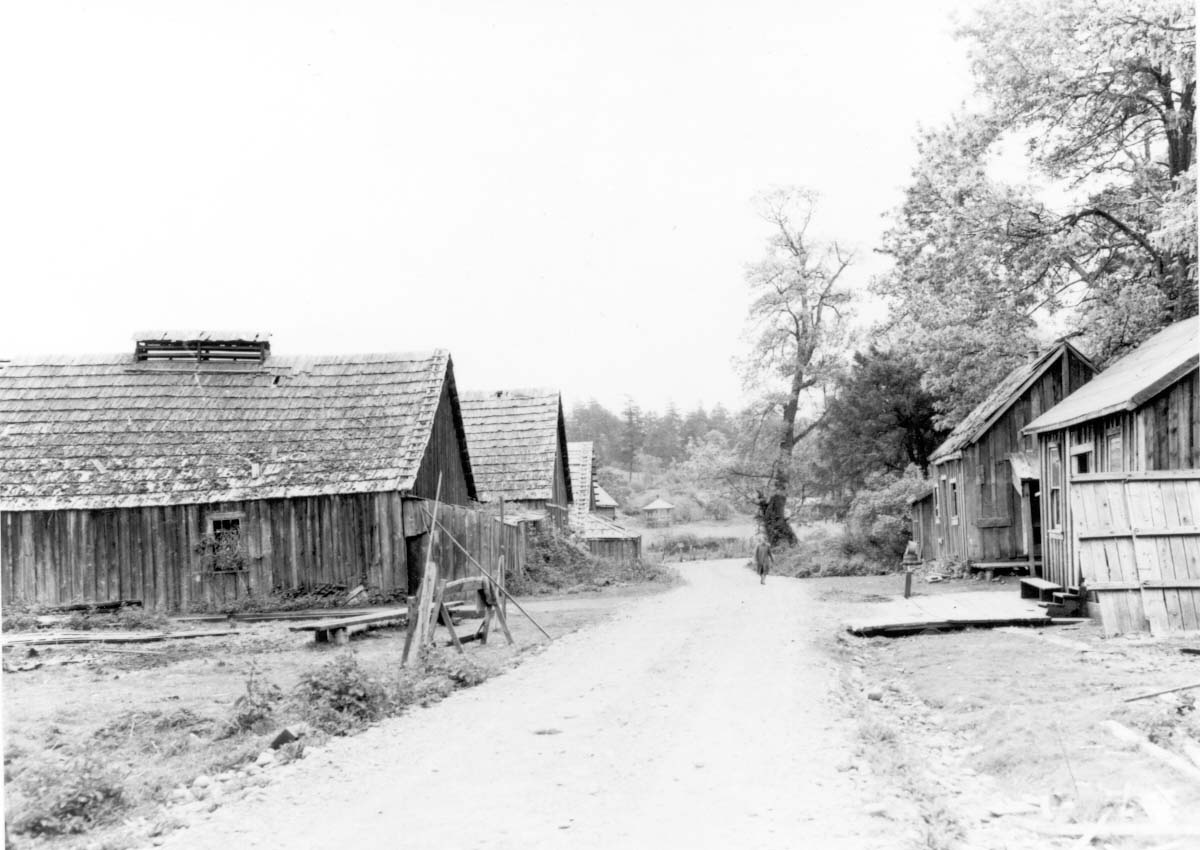
Jimmy Fraser’s Portrait
I was 12 years old when I first saw a photograph of a painting of Jimmy Fraser that appeared in a Magazine. The painting was made by my artist cousin Tomas Stock,. Much later, I saw a Victoria Times newspaper story of January 20, 1960, with the title: “Temperament of an Artist, Vision of a poet”. It shows my late cousin painting a portrait of Jimmy Fraser and quotes his comments from his visit with Jimmy.
This gives a bit more of the personal story of Jimmy: “Tom Stock of Montreal, who is doing a series of portraits of B.C. Indians for Weekend Magazine …included the grey haired 82-year-old Indian living on the Craigflower Reserve as among his ‘musts’. Wonderful Guy. ‘Jimmy is a wonderful guy’ said Mr. Stock. ‘He’s got the temperament of an artist and the vision of a poet’. He comes from a world that is gone – a world when man was closer to nature and the basic things of life’. …Mr. Stock found Jimmy living in a one room shack and suffering somewhat from meager means. ‘His roof leaks and he has no electricity’, he said. ‘And if it wasn’t for some relief he gets now and again, he would be really up against it’. Mr. Stock, who has hobnobbed with Indians and Eskimos for many years, feels strongly for the Natives of Canada. ‘They are intelligent people who want to improve their way of life”, he said. ‘They want to attain and acquire the best of their own cultures and white mans traditions. Remember, we took everything away from the Indian’ he said”.
Jimmy Fraser’s Family
Living relatives of Jimmy Fraser are not easy to find, because so many are related through female lines, where names change frequently and families lose touch over time. Like many other Lekwungen families, in the 19th and 20th centuries, Jimmys extended family intermarried over and over again with other Indigenous Nations throughout Vancouver Island, the Lower mainland and Northwestern Washington. This common, but often unrecognized, movement of Indigenous peoples in the larger area is best exemplified in the work of Socio-cultural Anthropologist and Ethnohistorian, Dorothy Kennedy: Threads to the Past: the Construction and Transformation of Kinship in the Coast Salish Social Network (Kennedy 2000) and Looking for tribes in all the wrong places: an examination of the Central Coast Salish social network (Kennedy 1995).
Jimmy’s notoriety was often prefixed by pointing out that he was the grandson of Chee-ah-thluk (King Freezie), the first Lekwungen person recognized as a “chief” by the employees of the Hudson’s Bay Company, when they occupied the region.
In Appendix 1, I have put together a partial genealogy of Jimmys relatives that can be greatly expanded upon in many directions for those people wishing to do so.
Jimmy the Council Member
Figure 7. Shows the Songhees Chief and council with Jimmy on the far left. Jimmy Fraser was on the Band council during the lengthy negotiations leading up to and during the transfer of the Songhees Reserve from the Inner harbour of Victoria to Esquimalt harbour in 1911 (Keddie 2003).
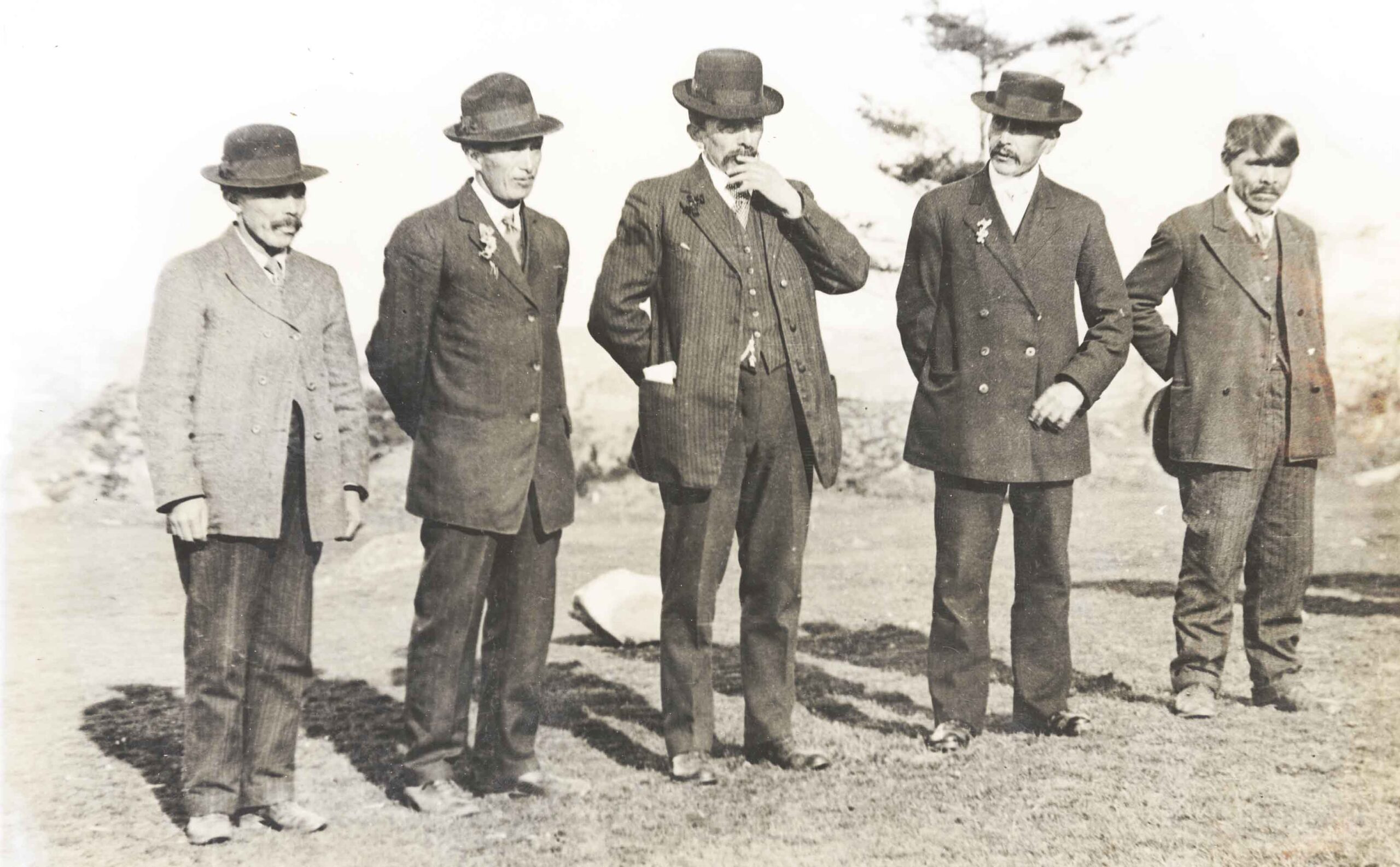
Frasers Coming of Age Ceremony
A big event in the life of Jimmy Fraser was his communing of age ceremony on February 8, 1898, when he was 22 years old. It was performed in one of the large plank houses on the Old Songhees Reserve in Victoria Harbour.
The Daily Colonist reported the event on February 9, 1898, under the title and sub-titles: “A Big Siwash Dance”; “A New Medicine Man and Dance Springs into Existence on the Reserve” and “’Jimmy’ Fraser in his new creation in the Theatre – A Weird Dance”. The paper demonstrated their usual bias way of showing a misunderstanding of Indigenous culture, and using today what is considered inappropriate language.
The newspaper reported that Jimmy Fraser had dreams that he needed to reveal. With 150 people watching, a huge fire was built in the centre of a “big house” across the bridge on what is now the Old Songhees Reserve:
“Jimmie, like all the great actors, kept his audience waiting. The silence became impressive. Then, with a wild and unearthly whoop, Fraser, his head bedecked with feathers and his face hideously painted, sprang into the ring. Like a French ballet dancer, he wheeled around the ring, apparently on one toe, at the same time chanting a slow melancholy air entirely out of keeping with his lightning-like movements.
Then the fun commenced in earnest. Gutteral remarks, apparently indicative on the high esteem the young dancer was already held in were first heard from some of the older Indians, and finally the old and young klootchman [women] joined in the general chorus and raised a hideous ear-splitting din.
Jimmy received his honors as calmly as his dance would permit. For a time, he made no effort to do more than to remain on the earth paved floor one minute out of five. At last getting down to business he broke fourth in song. He sang of his numerous dreams of recent date, in which a particularly wise old owl told him that he was destined, not only to become a great dancer, but also a great medicine man who would work wonders on the reservation.
At the expiration of ten minutes by the chief’s watch , Jimmy looked the least bit fatigued, but he would not give in. The pounding on the wooden benches surrounding the charmed circle and the beating of drums commenced with redoubled vigour. Jimmie had to continue. Then commenced a series of contortions well worth of the high paid Oriental dancers. The chant was taken up by the spectators who continued it in a low monotone impressively melancholy. ….. Chief Cooper explained that the dance introduced by Jimmie was the Meathla, a solemn sort of an affair, much conducive to joy among the Indians”.
Jimmy Fraser the Historian
Jimmy Fraser (Figure 8),was an important source of information on Lekwungen culture and history. His main work was with the (then) Provincial Museum curator of ethnology Wilson Duff, who recorded stories, events, resources and place names on the landscape. These are in unpublished field notebooks in the RBCM archives (Duff 1951-52) and published in The Fort Victoria Treaties (Duff 1969). Fraser also provided information to anthropologist Wayne Suttles who interviewed him in 1949 and 1960. Anthropologist, Michael Kew did a interview with Fraser, on May 16, 1955 (Kew 1955; RBCM Archive tape STR-T-002).
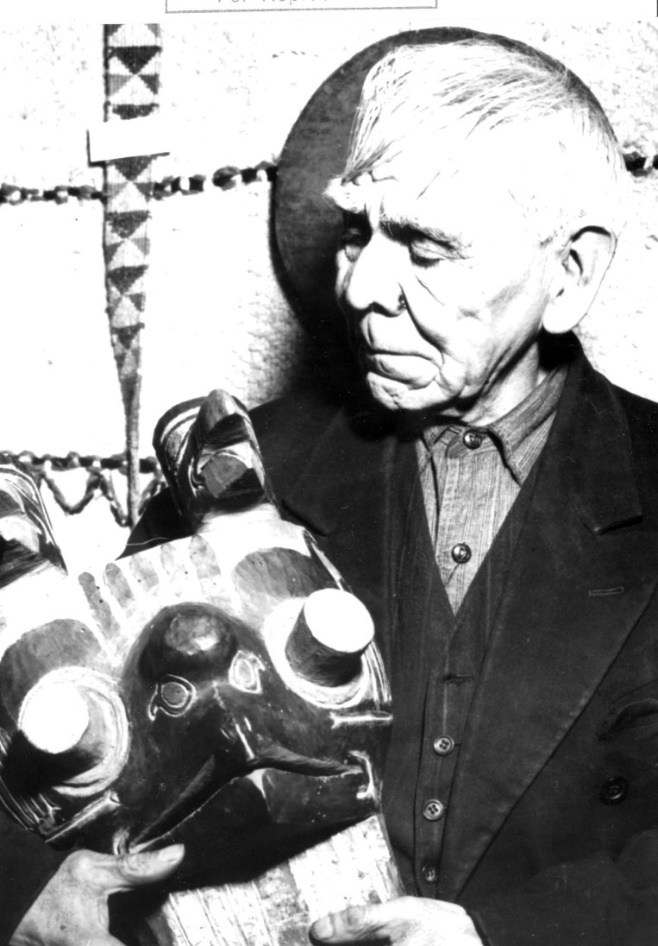
An example of one of Jimmys many stories was recorded in the Colonist newspaper for June 3, 1955: “The story-telling session was held at the request of Jimmy, who feels that when he dies the legends and beliefs of his people will be forgotten. The young people of his tribe, he claims, are forgetting the culture of their forefathers. Museum officials took a tape recording of Jimmy’s stories to preserve them for posterity. … Jimmy settled down to telling several legends connected to the places in and around Victora. One of these concerned Mount Douglas. Its Indian name is ‘Chu-utchin’, meaning heavenly mountain. According to Jimmy, a spirit dwells in the mountain. He related many years ago the Indians were warned by a divine person that a great flood would cover the world. As an act of grace, he said the divine person changed himself into a mountain in order to enable the Indians to tie their canoes to its slopes during the flood”.
Newspapers and others recorded several versions of Jimmy’s stores about the legend of Camosun that takes place at the Gorge falls near the Tillicum Road bridge (Keddie 1991).
Jimmy Fraser’s Other Activities
Jimmy seemed to live an active life in his early years but we can only learn some of it from the occasional newspaper article. Only 8 months after his coming-of-age ceremony, The Daily Colonist reported on October 19, 1898, that “Jimmy Fraser of Victoria is gathering the natives in large numbers about Vancouver. On being questioned he said he was organizing a potlach and wedding ceremony perpetuating some of the ancient customs of his tribe”.
On October 9, 1903, Jimmy Fraser is noted under a Colonist article: “Good Racing at Exhibition”. Horse racing at the Bowker Park race track, near todays Willow beach, had an “Indian pony race” to win “the Klatawa purse”. The newspaper noted: “Songheesh Indians with their ponies, Jimmy Fraser on Salvador, Jimmy Marchall on Ferrenal, Antoine on Tenny and George on McChesney made an interesting race.”,
Name Changing Ceremony at the Legislative Buildings
On June 18, 1950, Jimmy Fraser had a special ceremony which involved adopting his grandfathers name, Che-ahk-lacht, and making a visit to see his grandfather’s picture at the Provincial Library. Johnny George (Aye-you-whom), ( 1876 – September 1, 1961), from the Somenos Reserve near Duncan (known then as the song leader for the Cowichan drama Tzinqua), was the master of ceremony. He was accompanied by Agnes Johnny of Duncan; Marie and Mary Loha, who were noted as being descended from the Cowichan Chief Loha; and David Aleck from Koksilah, dressed in a European style suit, was the interpreter (Figure 9).
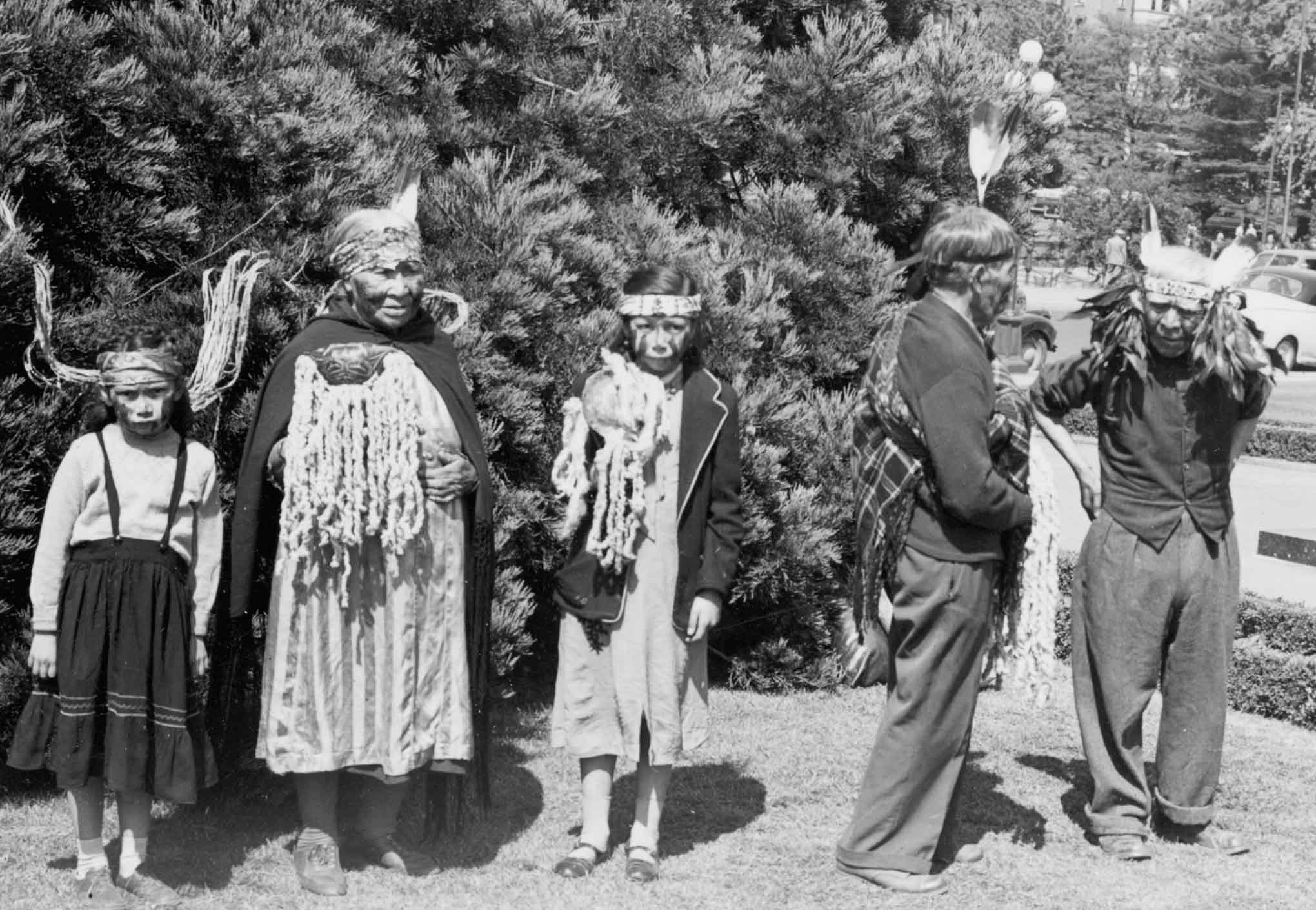
This event is first mentioned by Betty Newton, then a Provincial Museum artist and later a museum technician, who often visited the Songhees Reserve. She became friends with Jimmy Fraser and recorded some Songhees history from him.
On a document dated April 15, 1950 she stated:
“Jimmy Fraser wishes (and is) coming with a small delegation on a pilgrimage to see his grandfather’s picture in ‘The Big building at Victoria’ where they keep it safe. He will let the people who keep the records know when he is coming. He is also telling the press so that the public will know” (Newton 1950). The local writer and newspaper author Bruce McKelvie was the one who participated and took the photographs shown here (McKelvie 1950).
Jimmy had a previous history with Johnny George, when he was initiated into the secret Blackface society to perform the blackface dance and kept inside a house for five days. It was Johnny George who “painted his face” at the legislative buildings. “He prayed for me. Prayed for door before you went in” (Duff 1951-1952).
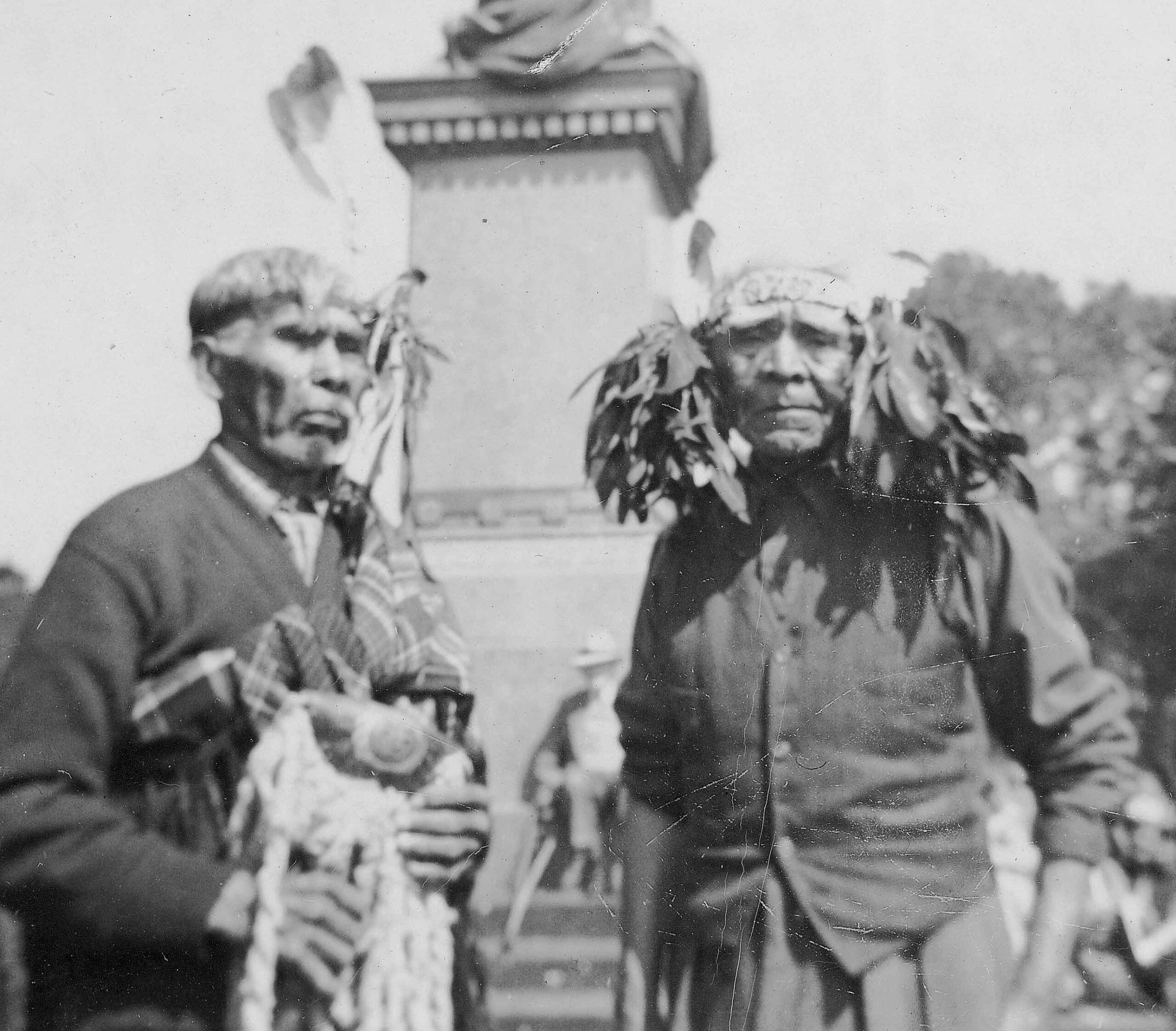
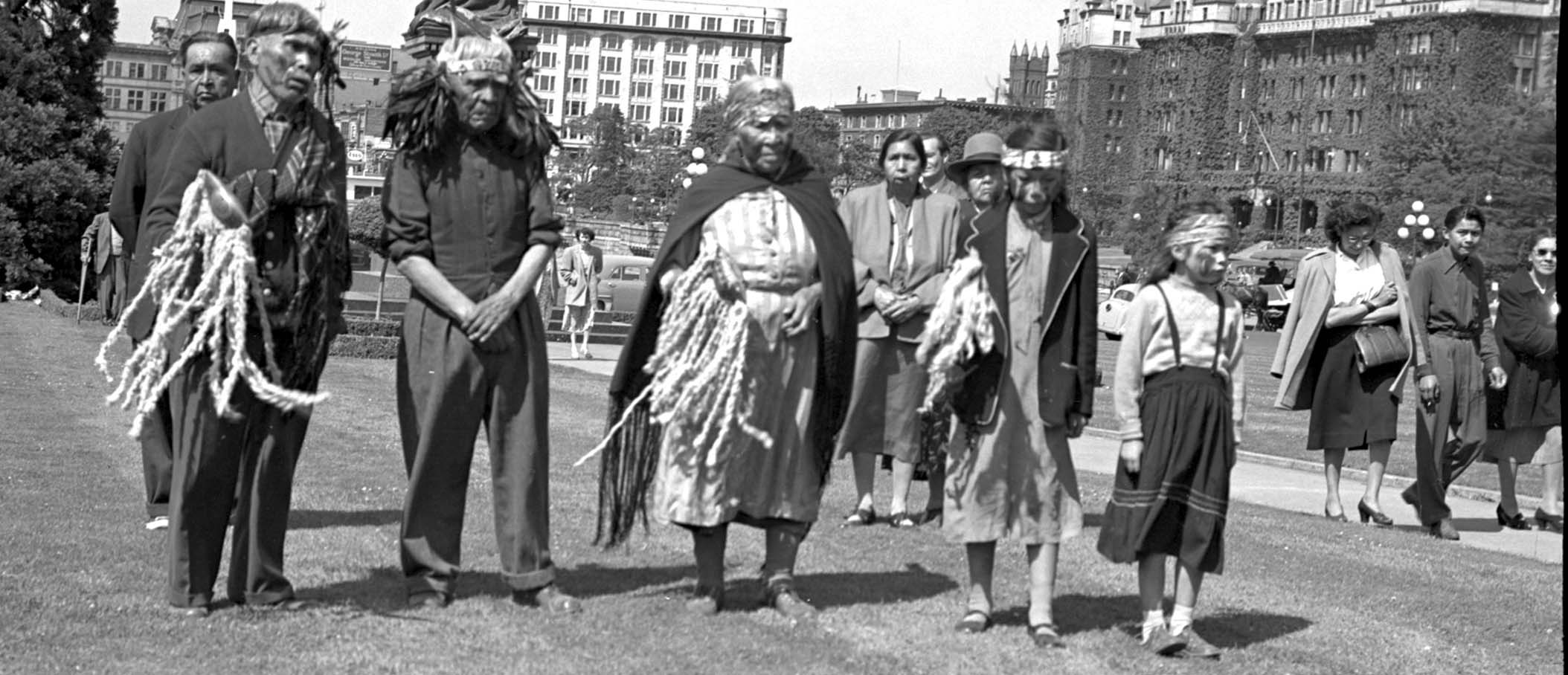
In a separate manuscript there is a reference to this naming event which talks about the use of a special ceremonial item called a “Schlo-Une”. This is “a strip of the inner bark of the Cedar tree. It is about two yards long. A shaman was asked during a curing ceremony about the Schlo-Une: “I once saw the Schlo-Une handing on a bush in the grounds of the Parliament Buildings in Victoria, B.C., That afternoon Jimmy Fraser of the Songhees Band had held a little ceremony in honour of his father [grandfather] chief Frazee whose photograph he had been shown in the Provincial Archives. He was later photographed but hung his Schlo-Une behind that bush that it might not be seen by the public” (Cryer c.1950s). Betty Newton recorded that it was Josephene Thomas who: “Made ceremonial cedar bark towel for Jimmy Fraser of Songhees I. R. when he took his grandfather King Freesy’s , Che-ahk-lacht, at Queen Victoria’s statue & did honour to him in ceremony one Sunday in the Provincial Library with 40 others.” (Newton c. 1950s)
“His towel was used to clean paint off face before you went into buildings to see grandfather. Sposed to hang it on Christmas tree (D. Fir)” [This would likely refer to the large California Redwood at the north end of the property].
Appendix 1.
A Partial Overview of Jimmy Fraser’s Genealogy
Jimmy Fraser was the grandson of “Cheachlacht” or “Chee-ah-thluk” who lived in a village in Cadboro Bay before the coming of Europeans. His name was also anglicized as “ Tsil-a –thuck”, “Tshiashac” ,“Tsil-al-thack” and “Chea-clach” but he was usually referred to as King Freezie or Frise. He was recognized as a chief from 1843 until his death in 1864. As an adult he was baptized as Jean Baptiste on March 17, 1850, but never used this name assigned to him by a priest. He was recorded by the priest as “King Frise” and “Great chief of Sangue”. His Clallam wife, Coalitza, was baptised at the same time (B.C. Archives Mfilm B16242).
Charley (Soke) Frise (c. 1858 – October 13, 1894).
It was claimed that Chief Feeezie had ten wives. One of his sons was “Charley Frise” (Soke or Sock), born about 1858. Baptised Oct. 3, 1863 (RBCM Mfilm #B16242). Charley was chief from October 21, 1892 until his untimely death at age 36, on October 13, 1894. He had a son named Alfred Freezy, born July 1886, whose mother was named Tarse and a daughter Emma Freezy, born Feb. 13, 1893, whose mother was named Maria.
One of Charley’s daughters was Sally Freezy. She and her first cousin Sarah Wheedrisk had children with Frank Albany. Sarah was married first to Frank Albany, and after his death to Chief Micheal Cooper. Sarah Coopers father is listed as “Peters” on her death certificate. She died, “widowed”, at age 87, on September 1, 1943. Sarah’s grandson, John Albany, was chief from 1954 to 1991. Charlie’s daughter Mary Anne (Chathough) married Louie Jackson and then Charlie Kamia.
Louie (Louis) Unsame Fraser (1841-1891).
Chief Freezie’s second son was Louie (Louis) Unsame Fraser, whose mother was a (unnamed) Twana Woman (One of several of King Frise’s wives).
Louie was Jimmy Fraser’s father. Jimmy’s mother was Mary (no last name) from Kuper Island. Jimmy was christened on Kuper Island in 1874. When Jimmy Fraser’s mother was very young, she survived the smallpox. She was first married to a Saanich man who ran away when she had small pox.
Elizabeth “Anne” Fraser (1875 – Oct. 17, 1940).
Elizabeth was Jimmy’s sister, who was married to a Songhees, Daniel Joseph (c.1879 – May 4, 1929; Occupation: Steam doc helper. Their children were:
Samuel Fraser Joseph (June 26, 1902 – April 24, 1968). (Reg. no. 1968-09-008615). Dock Freight handler. At age 35, he married Flora Thomas, age 19, from the Clo-oose Reserve) on Jan. 31, 1938. (reg. no. 1938-09022033). (Father: James Thomas and Ida Wilson of Clo-oose).
Lena Joseph. (Dec. 12, 1912 – Feb. 16, 1972). (reg. no. 1972-09-004829). Married to Alymer Joe. Daughter: Margarie Jimmy.
Sophie Joseph. (Died: August 25, 1942 in Duncan, age 5) (reg. no. 1942-09-02,
Fraser Joseph. (Born: 1918). Truck driver. Married at age 24, Oct. 27, 1942 to Margaret James, age 20, Malahat Reserve (reg. no. 1942-09-026179). Margaret’s mother’s maiden name is “Bill Aggie” and her father is James Babtist.
Edith Joseph. (no information).
Adeline Sadie Joseph (Songhees). Born: c.Nov.,1926. Died: May 24, 1929 (2yrs 6 month) (reg. no. 1929-09-013645).
Daisy Florence Joseph. Born: c, July 5, 1922. Died: Feb, 9, 1924. (age 1 yr, 8 months, 4 days) (reg. no. 1924-09-008302).
Louie Freezie’s brother was a Songhees (no name) who was the father of Robbie Daniel of Cowichan Bay, who Jimmy Fraser referred to as a nephew. Robbie later moved to the Songhees Reserve. Jimmy Fraser indicated to Wilson Duff that “Robbie Daniel of Cowichan Bay wants to give Songhee’s name to his son and daughter”. Jimmy said that Robbie’s mother’s brother had a big party at Victoria around 1904, but no name was provided (Duff 1951-52).
When Robbie Davis (Born: Mar. 2, 1882) died, on March 3, 1960, it was reported March 6, in The Daily Colonist, that his survivors were his “uncle Jimmy Fraser, two nephew, and two nieces, the children of Elizabeth and Daniel Joseph, Sam Joseph, Fraser Joseph, Lena Joseph and Sophie Joseph (There may be some confusion between Robbie Daniel and Robbie Davis). When Jimmy died on November 28, 1967 at the age of 89, in a hospital in Sardis near Vancouver, his obituary gives his survivors as “his Nephews Samuel Joseph of Victoria and Fraser Joseph who moved to the US and his nieces, Mrs Lena Joseph of Victoria and Mrs Sophie Trise of the U.S.” (The Daily Colonist, December1, 1967; March 6, 1960). Robert Davis’s parents are listed as “Charles unknown” and “Cecelia Naowhen”.
References
Cryer, B. M. c.1950s. Legends of the Salish. RBCM Archives F 8.2 C88. Donated July 18, 1967.
Duff, Wilson. 1969. The Fort Victoria Treaties. B.C. Studies, No.3 (Fall).
Duff, Wilson. 1951-1952. [Northern Straits ethnographic field notebooks], Wilson Duff Collection, File 50. Notebook No. 11, STR-W-001; Songhees notes from Jimmy Fraser. Library and Archives Division. Royal British Columbian Museum, Victoria.
Keddie, Grant. 2023. The Smallpox Epidemic of 1862. Web WordPress grantkeddie.com
Keddie, Grant. 2003. Songhees Pictorial. A History of the Songhees People as Seen by Outsiders, 1790-1912. Royal B.C. Museum.
Keddie, Grant. 1991. The Legend of Camosun. Discovery: Friends of the Royal British Columbia Museum Quarterly Review 4(5). Also at grantkeddie.com
Kennedy, Dorothy. 1995. Looking for tribes in all the wrong places: an examination of the Central Coast Salish social network. Masters Thesis. University of Victoria.
Kennedy, Dorothy. 2000. Threads to the Past: the Construction and Transformation of Kinship in the Coast Salish Social Network. Doctoral Thesis. University of Oxford (Exeter College), Institute of Social and Cultural Anthropology.
McKelvie, Bruce. 1950. RBCM Archives. Bruce McKelvie Album. Archives box #97909-46; MS-0001, box 7,file 3).
Newton, Betty. C. 1950-1955. Information on back of photograph of “Mrs Josephine Thomas”, PN53375, donated by Betty Newton.
Newton, Betty C. 1950. Notes on Jimmy Fraser. Deposited with the Archives April12, 1950.
Newton, Betty C. c.1950). Written Straits: A story told to Betty Newton by James Fraser Unthame Cheachlacht, Songhees Indian. RBCM Archives File GR-2809.54.
